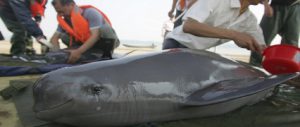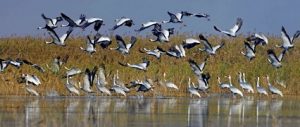At 4,000 square kilometres, Poyang Lake is China’s largest freshwater lake and one of the world’s most important wetlands. Eighty-seven types of migratory bird spend the winter in this corner of Jiangxi province, in south China, including 11 endangered species.
Nearly 100,000 swans land here every year, according to the Poyang National Nature Reserve. Accompanying them are almost half the world’s swan geese, hooded cranes and white-naped cranes, along with 95% of all oriental storks and 98% of Siberian cranes. For the Siberian crane, the lake is particularly important – only 3,000 of these birds survive, and this is their last remaining winter habitat.
More birds winter at Poyang Lake than anywhere else in Asia, but unofficial data suggests the number is falling every year, and already only a tenth as many come as a decade ago. Some even call it the “Kekexili of southern China”, in reference to the hunting of the Tibetan antelope to near extinction in Kekexili, on the Tibetan Plateau, in the 1990s.
On the shores of Poyang Lake, a hard battle is being fought against poaching.
Old Xu has fished the lake for most of his life and knows all the local fish and bird species. He explained that the number of birds on the lake starts to increase in late September or early October. They fly to Poyang along the channel that connects the lake to the Yangtze, and then spread south. By the middle of February, the first birds have reached the waters of Xinjian county, where Xu lives. At the end of the month, they start to fly away again. “By the time the rains come in April, they’ve more or less all gone,” said Xu.
When the lake is full, the waters spread out to the horizon. But in the dry winter and spring, the water level drops, exposing the sandbanks. Bird lovers – who flock here from all over the country – find they can walk right across the lake in their rubber boots. The clear, shallow water doesn’t even reach their knees.
“There’s been no rain all winter and spring this year and, because of the Three Gorges Dam, there is less water coming downstream,” said a volunteer from the provincial capital, Nanchang. “Water levels have been much lower than normal – about half a metre lower.” This can be fatal for the birds: it means less food is available and poachers can reach their feeding grounds more easily. The most dangerous time is the poaching peak around Chinese New Year.
Just as the thin mud of the lake-bed starts to get crisscrossed with the footprints of feeding birds, the nets appear.
These nets, which become denser as you move towards the centre of the lake, are a crude but cheap way of catching birds. Bamboo poles are stuck into the lakebed at spaces of 30 to 50 metres and stretches of netting strung between them, with holes about the size of a fist. The nets aren’t tall (they stand about three metres high) but they are long. Usually two to three kilometres in length, but sometimes as much as five kilometres, they stretch into the distance, from the lake right onto the mudflats at Sanshan and Sishan.
These crude traps become a graveyard for migratory birds: bodies hang from almost every stretch of netting. In one spot, I saw three dead swan geese within two metres of each other, the signs of their struggle clear in the line wrapped repeatedly around their necks. Ten volunteers had spent two or three hours clearing seven kilometres of net, but the poles were still visible stretching off across the lake. “The nets are everywhere, it feels like you’re in a maze,” said one local volunteer. The traps are set up between nesting areas and feeding grounds, making journeys between the two perilous. Many birds are caught while hurrying back to their nests at night, or in foggy weather.
Local volunteers estimate that more than a thousand birds have been trapped this year. The numbers caught by other, less visible methods are unknown. Bird warden Huang Xianyin estimates that at least seven out of 10 of the birds caught are young swans.
“You can’t imagine how savage they are,” he said. Huang lives by the lake and, since 2005, has counted 20 or 30 motorbikes heading for the lake almost daily during the dry season. Later, he sees them driving back out, laden with bulging, nylon sacks. “You can fit 20 or 30 birds in one sack, so that’s 1,000 or 2,000 birds poached every day, and the bulk of those are swans,” he complained. “It’s like that every day during the migration season.” At their worst, the poachers drive tractors to the lake to load up their catch. Huang has chosen to report the poaching.
People need to make a living locally. And, in the 12 cities and counties surrounding the lake, many locals regard bird-hunting as a tradition handed down through generations. But the methods employed are increasingly destructive. As well as nets, barbed hooks and crude battery guns are also used, as are poison and powerful spotlights, killing off birds in large numbers.
A fisherman from the village of Changyi explained: “There’s a skill to using a spotlight. You need to know where the birds sleep and take your boat in that direction. Then you turn on the spotlight and the birds become paralysed – they won’t move, they won’t even make a noise, you can just pick them up.” Sometimes the pesticide carbofuran is injected into bait or simply poured over shallow shoals, killing off large numbers of feeding birds.
Huang has been ostracised from his community for continuing to report poaching. He has also been the victim of revenge attacks: his windows have been broken and his home vandalised. In 2005, his 10 mu (6,600 square metres) of rice crops were poisoned, ruining the harvest. Two years later, his three head of cattle were stolen in succession.
In 2011, the nature reserve gave Huang a job as a bird warden at Xinjian Migratory Bird Protection Station, with a monthly salary of 1,100 yuan (US$174).
The local government has bolstered efforts to protect the birds in recent years. In December 2009, Jiangxi provincial government approved seven new protection and monitoring stations at Xinjian, Yuhan, Jinxian, Hukou, Duchang, Xingzi and Jiujiang – in addition to those already existing at Dahuchi, Dachahu, Shahu and Wucheng. “If you include wildlife protection, the industrial and commercial authorities and the forestry police, the province as a whole has about 1,200 people working to protect the birds or fight poaching,” said one provincial government official.
Poaching is common at Poyang Lake because of the huge profits to be made. In pursuit of these profits, the poachers are becoming more elusive and more ruthless.
“The local farmers used to catch birds to eat, to improve their diet,” said a local wildlife protection official. “But for the last decade, it has mainly been about selling the birds on. And the more we try to stop it, the higher the prices become. It’s on a par with drug dealing for profitability.”
The black market value for poached birds has rocketed. Xu, the fisherman from Xinjian, said the poachers prefer to catch young swans, geese and wild ducks. Swans caught prior to Chinese New Year – before their flesh has acquired a grassy flavor – used to be worth less than 100 yuan (US$16). Now they can fetch 2,000 yuan (US$316) locally. After Chinese New Year, when the swans aren’t thought to taste so good, the value plummets to between 300 and 500 yuan (US$47 and US$79). If the birds are sold on to markets in Guangzhou, Shenzhen, Zhanjiang or Hangzhou, the price can go as high as 12,000 yuan (US$1,900).
“Catch one swan and you can earn as much as you would in a half a year of fishing. There will always be someone willing to take that risk,” said Xu.
The government has publicised the punishments for poaching, transporting or trading protected animals. Fines of between 12,500 yuan and 125,000 yuan (US$2,000 and US$19,700) can be imposed for poaching a Class 1 nationally protected bird, such as the Chinese Merganser, Siberian crane, white stork, golden eagle or eastern imperial eagle. Poaching a Class 2 protected bird, or birds receiving local protection, such as the swan, greater white-fronted goose or Chinese egret, is also punishable by fines of various levels.
Some poachers have already been jailed for 10 or more years, but the threat of heavy fines and long sentences has failed to halt the poaching. As one Jiangxi wildlife official pointed out: “Even a thousand officials working to stop poaching are a drop in the ocean compared to the number of people living around the lake.”
This article was first published in Southern Metropolis Daily, where Yang Xiaohong is a reporter.
Translated by Roddy Flagg
Homepage image from Wetlands International



